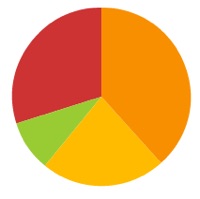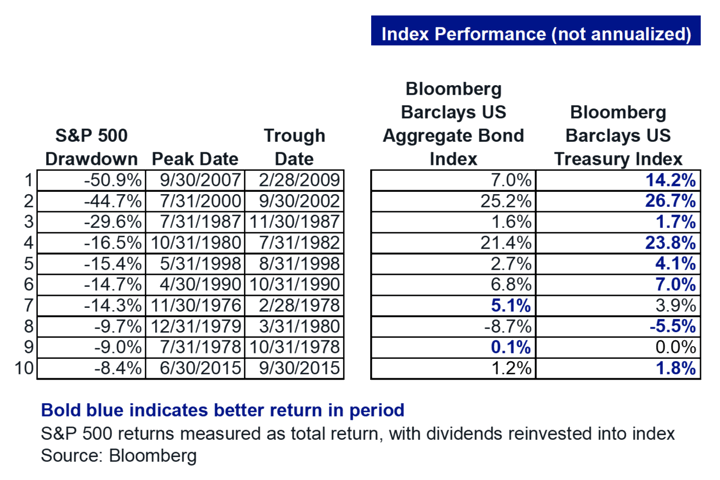 If you own bond mutual funds or ETFs, the most popular benchmark is the Bloomberg Barclays Aggregate Bond Index (AGG), which basically tracks all U.S. taxable investment-grade bonds, including US Treasury government bonds, investment-grade corporates, mortgage-backed bonds, and other asset-backed securities. The largest bond fund in the world is the Vanguard Total Bond Market Index Fund (VBMFX/VBTLX/BND), which tracks a slight variation of this index – the Bloomberg Barclays U.S. Aggregate Float Adjusted Bond Index.
If you own bond mutual funds or ETFs, the most popular benchmark is the Bloomberg Barclays Aggregate Bond Index (AGG), which basically tracks all U.S. taxable investment-grade bonds, including US Treasury government bonds, investment-grade corporates, mortgage-backed bonds, and other asset-backed securities. The largest bond fund in the world is the Vanguard Total Bond Market Index Fund (VBMFX/VBTLX/BND), which tracks a slight variation of this index – the Bloomberg Barclays U.S. Aggregate Float Adjusted Bond Index.
In an Advisor Perspectives article, Eric Hickman compares the “Total US Bond” index (AGG) to a Treasury Bond-only index and finds that the overall returns are very similar for both, but Treasury bonds perform better during a market drop. Thus, he concludes that Treasury Bonds Are the Only Bonds You Need.
I wanted to save this chart that lists the returns of both AGG and Treasury bonds during the 10 largest S&P 500 drawdowns since 1976. He points out that 8 out of 10 times (and during all top 6 drawdowns), Treasury bonds outperformed the AGG index.

My personal takeaway was that both Total US and Treasury-Only did pretty well. Right now, AGG has ~42% in US Treasuries and 22% in US government mortgage-backed bonds. If you were a professional advisor or a really detailed DIY investor, then yes, there is an argument for Treasuries only. (Because they are all equally creditworthy, you could even build your own ladder of Treasury bonds with zero expense ratio.) But if you hold a “Total US Bond” fund inside your 401k or target retirement fund, I would still be satisfied that it has historically served its purpose as the safer “ballast” of your portfolio. Overall, I would definitely focus more on keeping your expense ratios low, as the numbers above don’t account for the deduction of fund expenses.
 The Best Credit Card Bonus Offers – 2025
The Best Credit Card Bonus Offers – 2025 Big List of Free Stocks from Brokerage Apps
Big List of Free Stocks from Brokerage Apps Best Interest Rates on Cash - 2025
Best Interest Rates on Cash - 2025 Free Credit Scores x 3 + Free Credit Monitoring
Free Credit Scores x 3 + Free Credit Monitoring Best No Fee 0% APR Balance Transfer Offers
Best No Fee 0% APR Balance Transfer Offers Little-Known Cellular Data Plans That Can Save Big Money
Little-Known Cellular Data Plans That Can Save Big Money How To Haggle Your Cable or Direct TV Bill
How To Haggle Your Cable or Direct TV Bill Big List of Free Consumer Data Reports (Credit, Rent, Work)
Big List of Free Consumer Data Reports (Credit, Rent, Work)
I looked up the definition of “ballast” and the dictionary defines it as a stabilizer. If I needed a stabilizer I’d just add some guar gum to my diet. But in my portfolio I’m looking for yield and or return. And all the funds you mentioned and I’ll add in VCLT and VXWINX which I own, are barely above their 2014 highs and other then VCLT they all yield significantly less then 3%.
So in your mind is it just a matter of there is nothing else to choose from that fits your risk management profile or are you actually satisfied with the performance of these mutual funds and etfs?
Sounds overall like a strong argument for having some allocation in EE Bonds. Yes, there’s that liquidity issue. But your bond allocation (like your stock allocation) is not going to 0%. So there is room for some illiquidity in your bond portfolio. And a EE bond buying program provides for zero fee, US government, state-tax free, tax deferred, laddered investment. Just sayin’.
Treasuries are as safe as it gets. I’m very surprised that overall returns are comparable with a benchmark that includes mortgage-backed and corporate bonds. The benchmark needs to bring much higher overall returns to compensate for the risk. Why would anyone buy a Total Bond fund if overall returns are no better than Treasuries, yet the risk is much greater?
Note that these returns are only from peak to trough. I have to imagine the return to the total bond fund is noticeably higher then treasuries during troughs to peak periods. If you can time things perfectly great, if not–there’s still ample reason to invest in the total bond fun
Can you compare the 10-yr treasury rate at the peak for each drawdown? I am concerned that given current interest rates, significant appreciation in bond funds is not possible in the next downturn.
Is there an ETF that has good approximation to EE Bonds or I bonds to avoid penalties?
Or just shift to a bank’s Money Market Account?
A combination of VFIIX, PONAX, WHOSX, MACMX are all good “ballasts”. WHOSX particularly if you are looking to bring down your correlation.
I know the expense ratios on some of these may be above what people like, but they are well run funds.